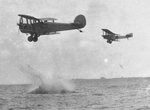michaelmaltby
Colonel
".... operational usage was the main game changer, not technology".
That is usually the case. Pointed stakes and pits dug in the ground aren't high "tech" but can sure be a game-changer against armoured cavalry. There is only so much "break through" technology -- but there is almost unlimited human imagination to determine operations and usage.
MM
That is usually the case. Pointed stakes and pits dug in the ground aren't high "tech" but can sure be a game-changer against armoured cavalry. There is only so much "break through" technology -- but there is almost unlimited human imagination to determine operations and usage.
MM


